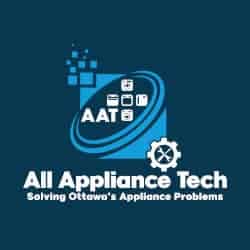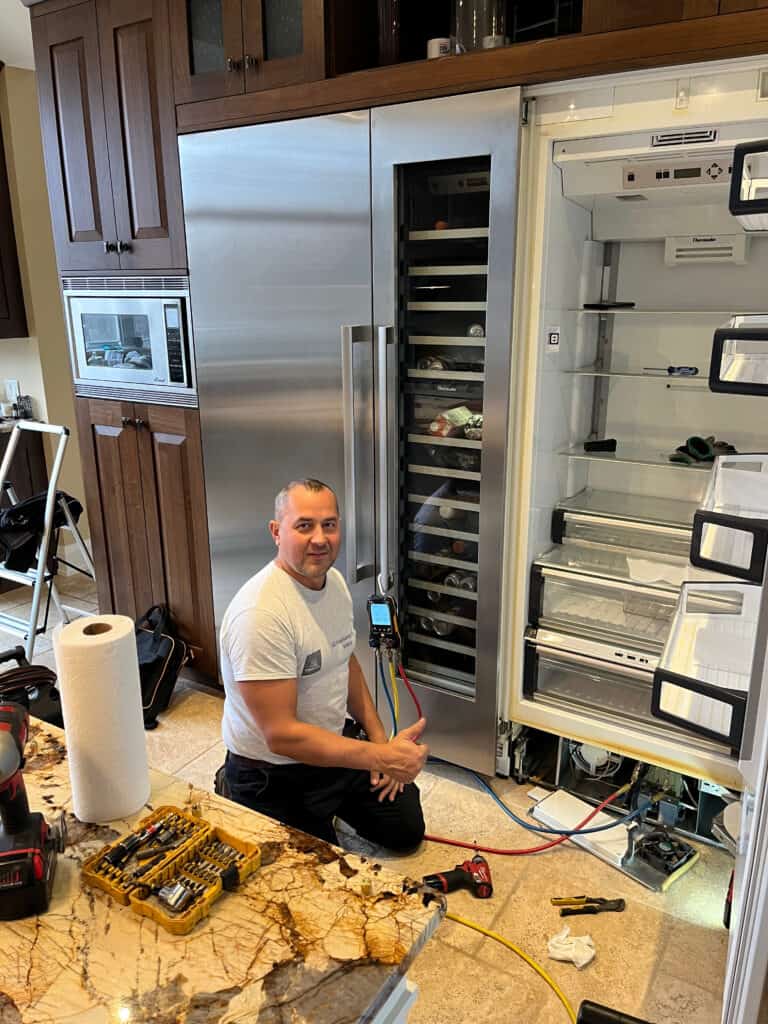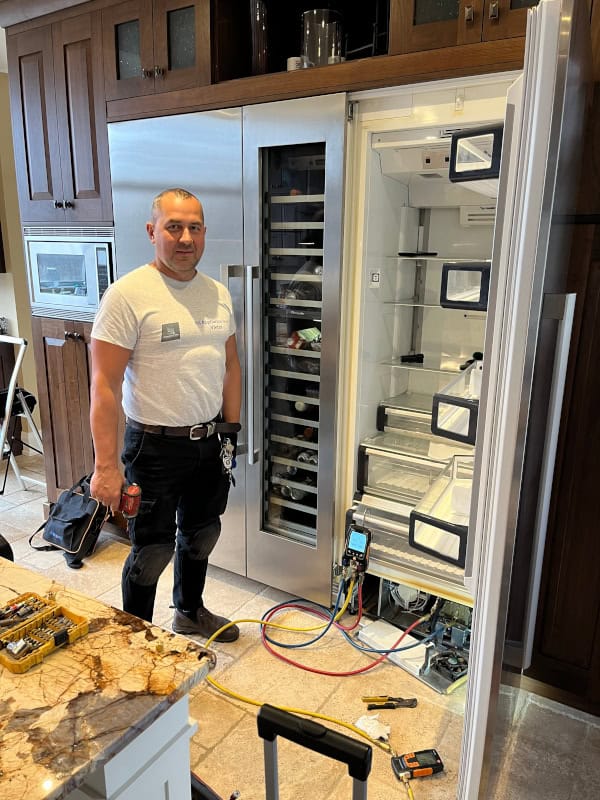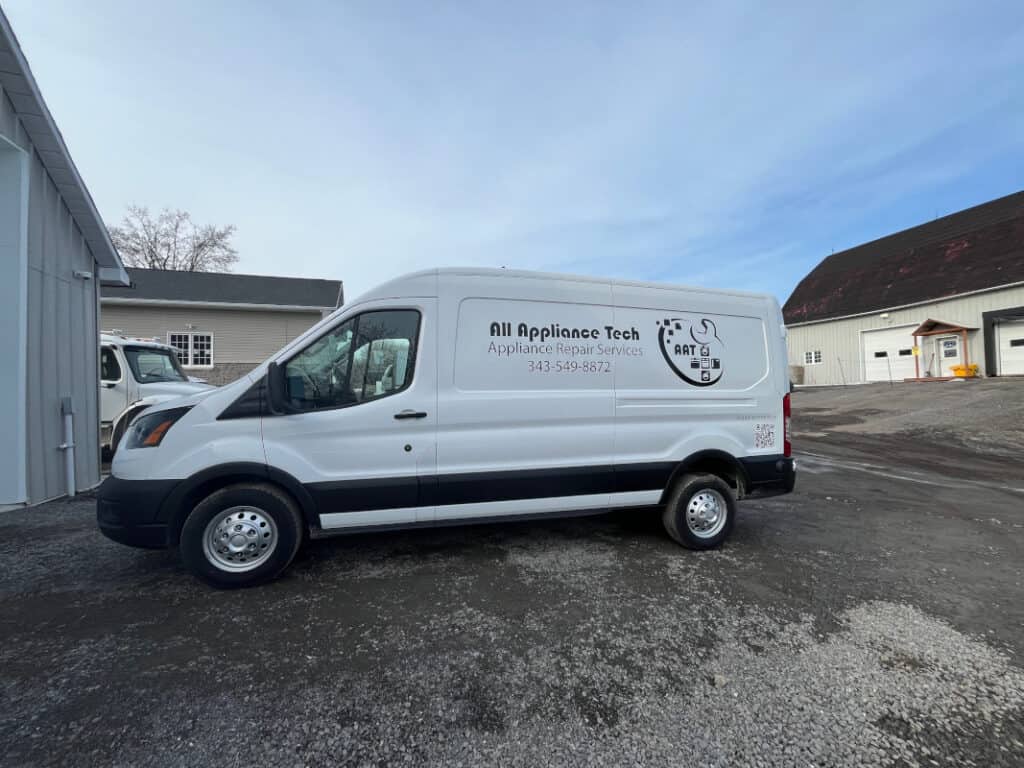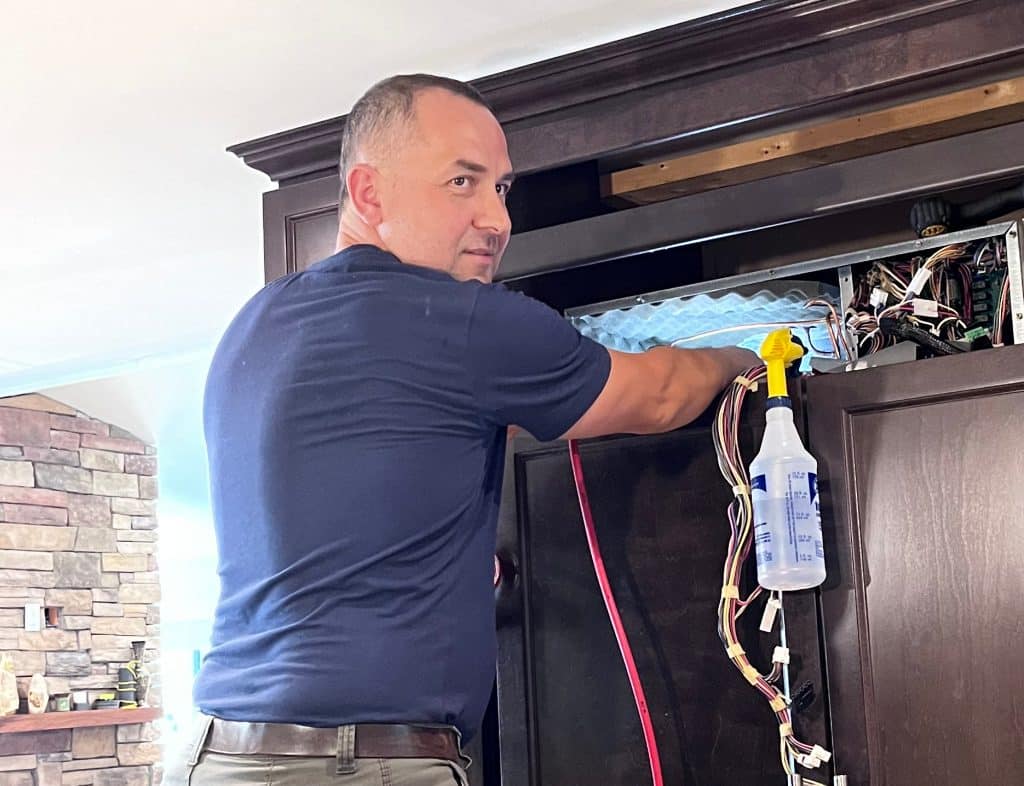How to Keep Your Thermador Fridge Running Smoothly
Hey there! Let’s talk about keeping your Thermador fridge in top condition. With a bit of knowledge and some simple steps, you can ensure it runs efficiently and keeps your food fresh. Your fridge’s sealed system includes the compressor, condenser, and evaporator. These parts work together to maintain the perfect temperature inside.
Keeping your Thermador fridge running smoothly has several benefits. It ensures your food stays fresh longer, which helps you avoid food waste. A well-maintained fridge also operates more efficiently, saving you money on energy bills. Additionally, regular maintenance can prevent costly repairs by catching issues early. Lastly, a reliable fridge provides peace of mind, knowing that your food is stored safely and at the right temperature. Now, let’s dive into the common problems and how to fix them.
For more detailed maintenance tips, check out our Comprehensive Monthly Guide to Fridge Maintenance.
Common Problems and Fixes
Thermador fridges can encounter issues such as refrigerant leaks and compressor failures. If your fridge isn't cooling properly or you hear hissing sounds, it might be a refrigerant leak. Strange noises or frequent cycling can indicate compressor problems. Spotting these signs early can save you from expensive repairs. If you notice these signs, it’s best to call a technician.
Example Story: If a technician were inspecting a Thermador fridge, they would listen closely for unusual sounds like hissing or rattling. These can indicate a refrigerant leak or compressor issues. They would also check the temperature settings to ensure the fridge is cooling properly. If it’s not as cold as it should be, it’s a sign something’s wrong, and further investigation or calling a technician would be recommended.
Diagnosing Problems
To diagnose issues with a Thermador fridge, technicians use several methods. Pressure testing checks the refrigerant levels. UV dye or electronic detectors can find leaks. Performance evaluations involve measuring voltage and amperage to ensure all components are functioning correctly. Regular maintenance helps avoid these problems. Keep an eye on your fridge's temperature, listen for unusual noises, and check for frost buildup. If you spot any issues, call a professional.
Example Story: In a real-world scenario, to diagnose issues with a Thermador fridge, a technician would start by checking the pressure levels with a gauge. This helps determine if the refrigerant levels are correct. Using UV dye, they would look for leaks that might not be visible to the naked eye. Electronic leak detectors are also handy for pinpointing the exact location of a leak. This thorough approach ensures no potential issue is overlooked.
Repair Process
When repairing a Thermador fridge, technicians access the sealed system by removing panels. For small leaks, they use soldering to seal them up. In cases of significant damage, they replace parts. After repairs, they recharge the system with the correct refrigerant and test it to ensure everything is working properly. Routine checks and timely repairs keep your fridge running smoothly.
Example Story: If a technician were repairing a Thermador fridge, they would begin by safely accessing the sealed system components. This might involve removing the back panel to reach the compressor, condenser, and evaporator. For small leaks, soldering is effective, but for larger issues, replacing damaged parts is necessary. After repairs, they would recharge the system with the appropriate refrigerant and thoroughly test it to ensure everything is functioning properly.
Maintenance Tips
Regular maintenance is key to keeping your Thermador fridge in good working order:
- Monitor Temperature: Regularly check that your fridge maintains a consistent temperature. Sudden changes can indicate a problem. Use a fridge thermometer for accurate readings.
- Listen for Noises: Unusual sounds like clicking or hissing can signal issues. If you hear something odd, it’s time to get it checked out.
- Inspect for Frost: Look for excessive frost buildup, especially around the evaporator coils. This can indicate a problem that needs attention. Open the freezer and examine the back panel for thick frost layers. If you find any, it's best to call a technician.
Example Story: When advising homeowners, a technician might suggest regularly using a thermometer to ensure the fridge maintains the right temperature. Listening for odd sounds can also help catch problems early. Inspecting for frost buildup, especially around the evaporator coils, is another key step. Thick frost layers can be a sign of issues that need professional attention.
Next Steps: Diagnostic Techniques
To effectively diagnose and address issues, technicians follow specific steps:
- Pressure Testing: Attaching a gauge to the system's service port to measure refrigerant pressure helps identify whether the system is undercharged or overcharged.
- Leak Detection: Using UV dye shows leaks under UV light, while electronic leak detectors can sniff out refrigerant gases.
- Performance Evaluation: Checking the efficiency and output of the compressor and other components involves measuring voltage and amperage draw.
These steps help pinpoint the issues accurately, ensuring the fridge is fixed properly.
Example Story: In practice, a technician would start with pressure testing to ensure the system’s refrigerant levels are correct. For leak detection, they might use UV dye and electronic detectors to identify and locate any leaks. Evaluating the compressor’s performance involves measuring voltage and amperage to ensure it’s running efficiently. These steps help accurately diagnose and fix any problems.
Repairing Your Fridge
When issues are found, technicians follow a systematic repair process:
- Accessing the System: Removing the back panel to reach the compressor, condenser, and evaporator.
- Leak Repair: Using soldering to seal small holes and replacing damaged components for larger issues.
- Recharging the System: Refilling the system with the correct type and amount of refrigerant.
- System Testing: Testing the refrigerator to ensure it is fully functional, monitoring the temperature, and checking for any recurring leaks.
Example Story: If a technician were repairing a Thermador fridge on-site, they would begin by removing panels to access the key components. Small leaks can often be sealed with soldering, but larger issues may require component replacement. Once repairs are complete, recharging the system with the right refrigerant and conducting thorough testing ensures the fridge is back to optimal performance.
Signs for Professional Inspection
Certain signs mean it’s time to call in a professional:
- Rapid Cycling: If your fridge turns on and off frequently, it needs a technician’s inspection. Take note of the cycling patterns. Significant changes mean it’s time to call a professional.
- Continued Performance Issues: Ongoing problems despite basic troubleshooting need professional help. If regular checks don’t solve the issue, schedule a maintenance check.
- Visible Leaks: Leaks around the fridge should be addressed right away. If you see any leaking fluid, turn off the fridge and call a technician immediately.
Conclusion
Taking care of your Thermador fridge doesn't have to be daunting. With a little understanding and regular checks, you can ensure it stays in top shape. Remember, early detection and professional help are key to preventing major issues. By taking these steps, you can keep your fridge running efficiently and avoid costly repairs. So next time you grab a cold drink from your Thermador, you'll know a bit more about the hard work going on behind the scenes.
These detailed guidelines will help you understand, identify, and address issues with your Thermador fridge's sealed system, enhancing your ability to maintain your appliance effectively.
Further Resources and Links
For additional tips and detailed guides on maintaining your appliances, check out these resources:
-
Comprehensive Fridge Repair Cost Guide for Ottawa: Learn about the typical costs associated with fridge repairs in Ottawa to better prepare for potential expenses.
-
Understanding Appliance Energy Efficiency: Discover how energy efficiency can save you money and help you choose the best appliances for your home.
-
How To Maintain Your Fridge To Prevent Breakdowns: Get practical tips on routine maintenance to keep your fridge running smoothly and prevent unexpected breakdowns.
-
Energy Star Guidelines: Find authoritative information on energy-efficient appliances and the benefits of maintaining them.
-
Consumer Reports - Refrigerators: Reference reliability data and reviews of Thermador and other fridge brands to back up your maintenance efforts.
Viktor Shkinder is the dedicated owner and leading technician at AllAppliance Tech & Repair in Ottawa. With years of hands-on experience in the appliance repair industry, Viktor is renowned for his unwavering commitment to honesty, integrity, and exceptional craftsmanship. His family-owned and operated business stands out in Ottawa as a beacon of trustworthiness, thanks to their dedication to never cutting corners and always owning up to their mistakes. Viktor's expertise spans across most major appliances, from dishwashers and dryers to microwaves and fridges.
Proudly serving his local community, Viktor values every personal connection he builds with his customers, often going the extra mile with same-day responses and quick appointment scheduling. When he's not busy restoring appliances to their optimal condition, you might find Viktor spending quality time with his family or exploring the beautiful landscapes of Ottawa.
For updates on appliance maintenance and repair tips, follow Viktor on LinkedIn. If you're in Ottawa and need expert appliance guidance, reach out – Viktor is always eager to help!
